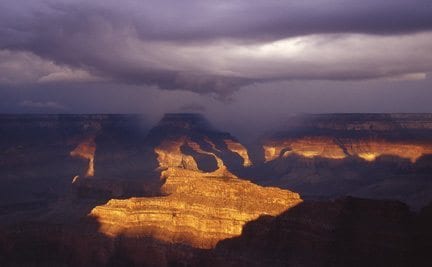Grand Canyon Experts | A conversation with Gary Ladd Part 2
Q What are you doing these days on trips in Grand Canyon?
A I am serving as an expert in photography and natural history in Grand Canyon for Wilderness Rivers – I’ve been on several of their trips. But, really all of the River companies are terrific in Grand Canyon.
Q What other things would you recommend, particularly for visitor who may not have as much time?
A Hiking down Cathedral Wash to the Colorado River is something good to do. Parts of it

Photo by Gary Ladd
are in the shade and it’s a mile or a mile and a half hike down to the River. But there are some sections you would not want to be in when it is flooding. And sometimes I’ve heard of hikers getting confused because you have to walk on benches and ledges to circumvent some small drop offs. Most people will find their way pretty easily, though. On the Cathedral Wash hike you get that first section in the sun, but you get to the first drop off and navigate around it and then it gets very interesting.
Q Can you recommend ideas for itineraries for visitors?
A In the Page – Lake Powell – and Glen Canyon National Recreation area, I recommend Antelope Canyon, certainly. It has gotten crowded and keeps getting more and more expensive (maybe about $27/hour/per person since you have to have a Navajo guide because it is on Navajo Tribal lands). But, it’s unbelievable, completely astounding. Upper Antelope Canyon is easier to walk through than the lower Antelope Canyon section. Lower Antelope is longer and has a series of drop offs and it has a metal stairway to descend into it. Down here you will find yourself in another world. It is only about 1,200 feet in length – but it seems longer. It is a twisting and turning slot canyon and you kind of worm your way through. After awhile you have to climb out – it’s about 100 feet. There are a series of metal stairways that allow you to descend into the Canyon… and one long one to take you back to the rim.
Q So, do you prefer the upper or lower section of Antelope Canyon?
A I really prefer the lower – it’s longer and offers more variety as well as a greater variety of things to photograph. It does have some pretty steep stairways, however. But, either section of Antelope is fantastic; they are both part of the Navajo Tribal Park System.
Q Where else in the Grand Canyon region do you like to go?
A Another place I recommend is Horseshoe Bend. It’s breathtaking. Your jaw will drop when you do this short hike near Page. The ground drops in front of your feet and at the end you are standing right at the rim of the canyon in Glen Canyon National Recreation Area. The access turnoff is within the Page city limits and the overlook is in the Recreation Area.
I also really like I like the North Rim. It is cooler up there in the summer. I like the big

Photo by Gary Ladd
ponderosa pines up there. Some of my favorite places in the Park on the North Rim include Pt. Imperial at sunrise and Cape Royal at sunset. Also, if you have time (and a sturdy four-wheel-drive vehicle) it is well worth the 17-mile trip (one way) on a dirt road to Pt. Sublime.
Q What suggestions do you have for visitors trying to capture Grand Canyon sunrises and sunsets?
A One thing I’m looking for is weather conditions that are changing – when there are clouds around. Personally, I’m not going to even take a picture – say at the North Rim – when the weather is clear. I have those pictures already and they are not as interesting. But, for sunrise if you have clouds overhead and a clear sky far off to the east – that can make a much more interesting photograph. So when the sun comes up with those conditions, that lends a lot of drama. If I had to describe what I would most want in terms of conditions for photography at Grand Canyon there would be quite a few clouds overhead and it would be clear for the first two to five degrees above the horizon. So when the sun first pops up above the horizon, that makes for a good picture. The summer monsoon season (early July to mid September) can be a good time – when the monsoon starts pumping in clouds and moisture to the Southwest.
I suppose it is hard to exactly describe the perfect situation for photography, though. Some of it depends upon luck. There is also something that’s sometimes jokingly called the 180 degree rule. So no matter what you are doing in taking pictures – occasionally there is something back behind you, so you simply turn around 180 degrees and look in the opposite direction to see what the light is doing, what the conditions are like in that direction. One time I was leading a photo workshop in Monument Valley and we were trying to get images at sunrise and we were looking eastward towards the rising sun. I just happened to turn around and got unique and interesting pictures of our all of our silhouettes reflected in the windows of the bus – it was a magnificent reflection off the windows.
Gary Ladd. Born in 1947, Gary Ladd spent his childhood in Ohio, Michigan and Missouri. He earned a BA from Central Methodist College in Fayette, Missouri in 1969 and moved to Tucson and was a research assistant at Kitt Peak National Observatory from 1972 to 1976. He also was research assistant and 60-inch telescope observer at Mount Hopkins Observatory from 1977 to 1979. Ladd moved to Page, Arizona in 1981 and his photographic interests have been the landscapes of the Colorado Plateau, especially Grand Canyon, Glen Canyon/Lake Powell, Vermilion Cliffs, Bryce Canyon and similar strong geologic themes. Gary Ladd was first published in Life Magazine in 1972, and since then his photographs have been widely published in Books, Arizona Highways, Air & Space, The Wall Street Journal, Modern Photography and others. He is author of numerous books including Grand Canyon Views: Beyond the Beauty and his new book: Lake Powell Unchained. Visit and view images at www.garyladd.com
Resources and for further reading:
Grand Canyon: Views Beyond the Beauty by Gary Ladd, Grand Canyon Association, 2008.
Lake Powell Unchained by Gary Ladd, self-published, 2011.



 https://pixabay.com/en/rafting-colorado-river-white-water-2095669/
https://pixabay.com/en/rafting-colorado-river-white-water-2095669/